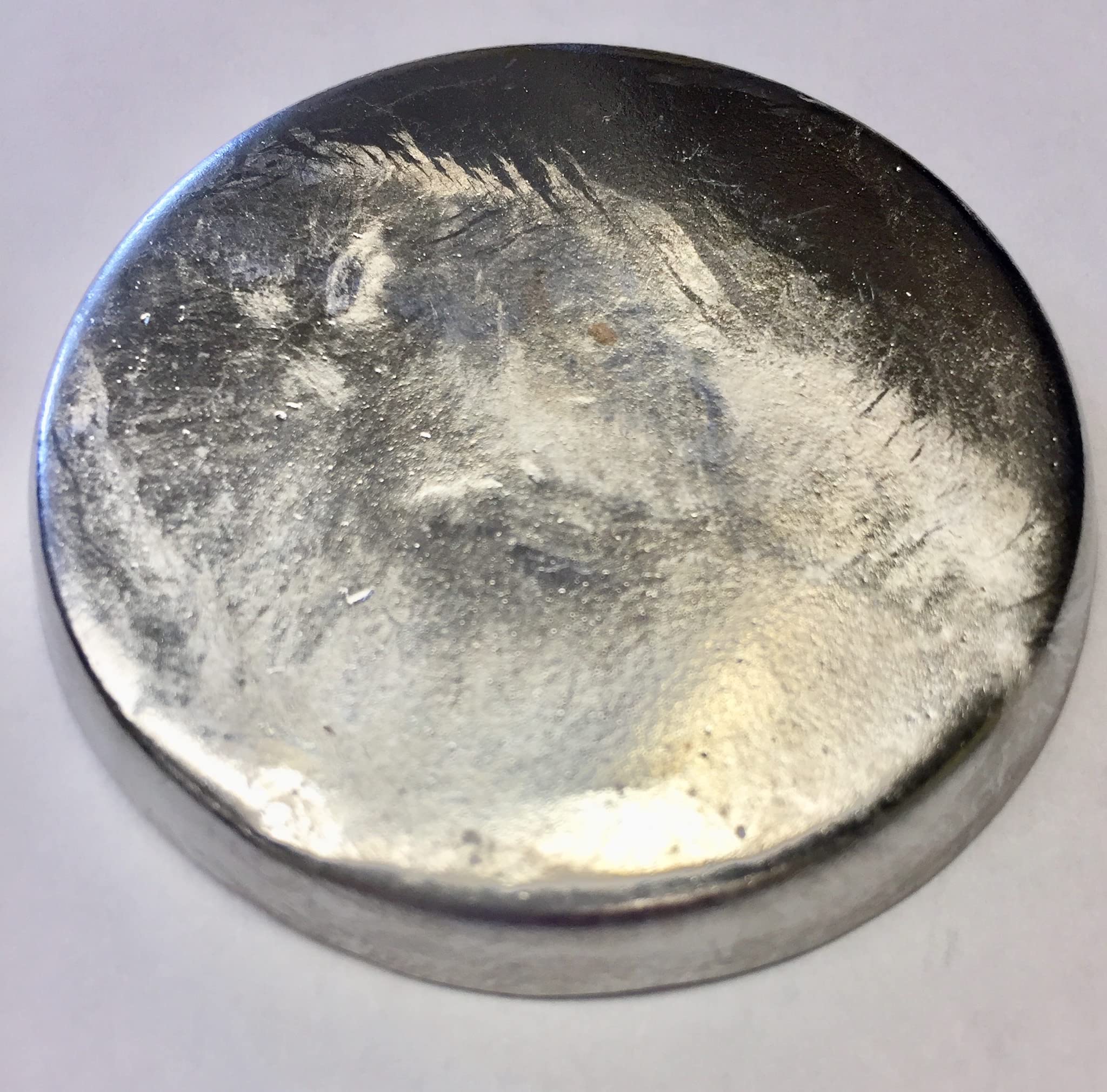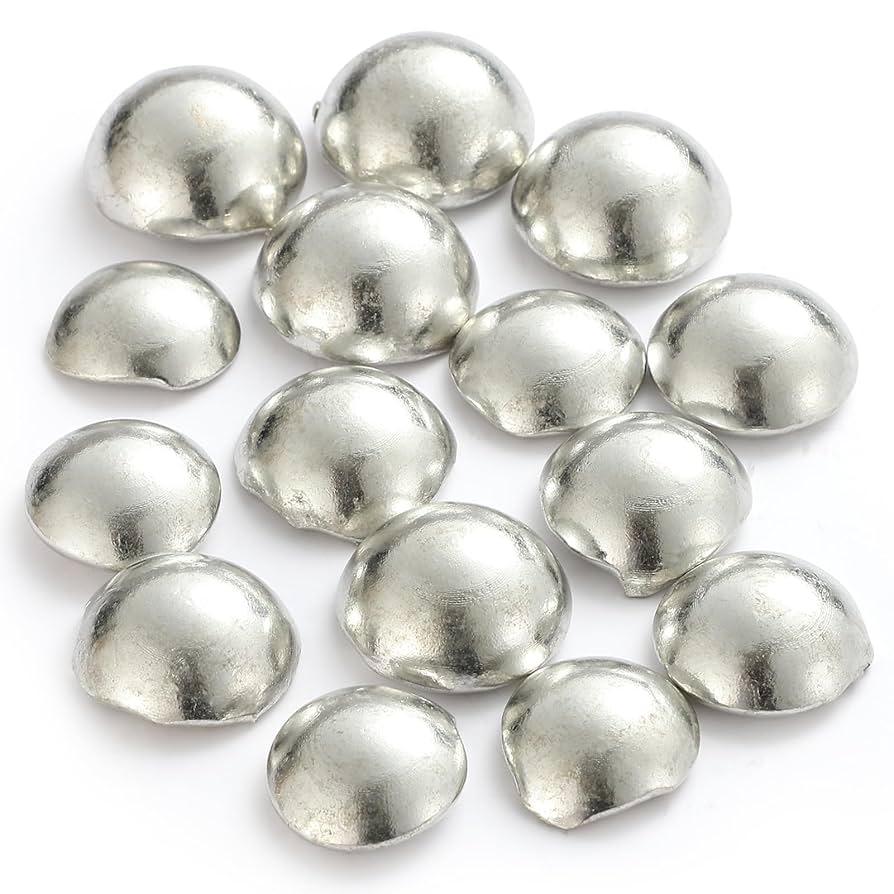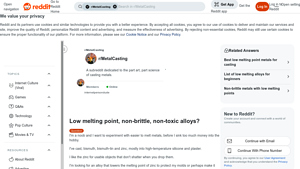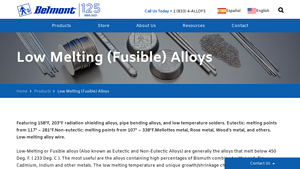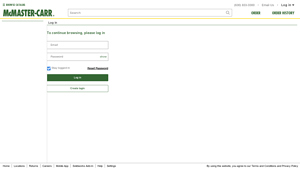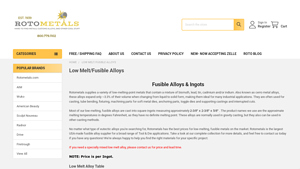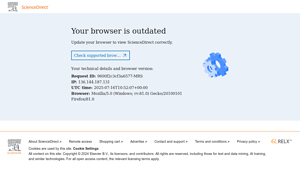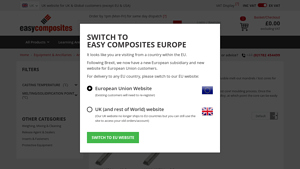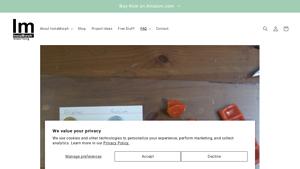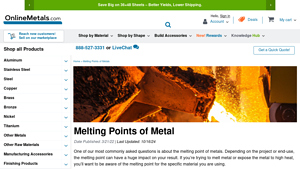Low Melting Point Metals For Casting Guide: Type, Cost, Top List…
Introduction: Navigating the Global Market for low melting point metals for casting
In today’s competitive landscape, sourcing low melting point metals for casting presents a unique challenge for international B2B buyers. As industries across Africa, South America, the Middle East, and Europe increasingly seek innovative and cost-effective solutions, understanding the properties, applications, and suppliers of these specialized metals is crucial. Low melting point metals, often used in diverse applications ranging from rapid prototyping to intricate die casting, offer significant advantages, such as reduced energy consumption during the melting process and compatibility with various mold materials.
This comprehensive guide explores the different types of low melting point metals, including their eutectic and non-eutectic alloys, and their specific applications across various sectors. It also delves into critical considerations for vetting suppliers, evaluating costs, and ensuring compliance with safety regulations. By equipping B2B buyers with actionable insights, this resource aims to facilitate informed purchasing decisions, ultimately enhancing operational efficiency and product quality.
Whether you are a manufacturer in Germany looking for reliable casting solutions or a supplier in Saudi Arabia aiming to diversify your offerings, this guide serves as your go-to resource for navigating the complexities of the global market for low melting point metals. With a focus on practical applications and strategic sourcing, you can confidently meet your business needs while staying ahead of industry trends.
Understanding low melting point metals for casting Types and Variations
| Type Name | Key Distinguishing Features | Primary B2B Applications | Brief Pros & Cons for Buyers |
|---|---|---|---|
| Eutectic Alloys | Lower melting points due to unique compositions. | Rapid prototyping, low-temperature soldering. | Pros: Energy-efficient melting; Cons: May require careful handling due to toxicity. |
| Gallium Alloys | Non-toxic, melts at low temperatures, reactive with aluminum. | 3D printing molds, electronics cooling solutions. | Pros: Low toxicity; Cons: Reactivity with certain metals can cause issues. |
| Fusible Alloys | Composed of multiple metals, designed for low melting. | Die casting, pipe bending, and radiation shielding. | Pros: Versatile applications; Cons: Some variants are toxic and require safe handling. |
| Bismuth-based Alloys | High bismuth content, low melting points, non-toxic options available. | Tooling, dental applications, and proof casting. | Pros: Non-toxic; Cons: Can be more expensive than traditional alloys. |
| Mercury Alloys | Contain mercury, very low melting point. | Limited industrial applications due to toxicity. | Pros: Effective in specific applications; Cons: Highly toxic, regulatory challenges. |
What Are Eutectic Alloys and Their Advantages for B2B Buyers?
Eutectic alloys are notable for their low melting points achieved through specific combinations of metals. They are particularly valuable in rapid prototyping and low-temperature soldering applications, as they require less energy to melt, leading to cost savings. However, buyers should be cautious due to the potential toxicity of some constituents, necessitating proper safety measures during handling.
How Do Gallium Alloys Stand Out in Low Melting Point Metals?
Gallium alloys are unique due to their low toxicity and ability to melt at relatively low temperatures. They are especially useful in applications like 3D printing molds and electronic cooling systems. However, buyers need to consider the reactivity of gallium with metals like aluminum, which can limit its use in certain environments.
Why Are Fusible Alloys Important for Various Industries?
Fusible alloys are engineered for low melting points and consist of multiple metals. They find applications in die casting, pipe bending, and radiation shielding, providing versatility across industries. While they offer diverse uses, buyers should be aware of the toxicity associated with some formulations and implement appropriate handling protocols.
What Makes Bismuth-based Alloys a Preferred Choice?
Bismuth-based alloys are characterized by their high bismuth content, resulting in low melting points and non-toxic properties. They are commonly utilized in tooling, dental applications, and proof casting, making them attractive for buyers seeking safer alternatives. However, the cost of bismuth may be higher than that of traditional alloys, which could impact budget considerations.
Are Mercury Alloys Still Relevant Despite Their Risks?
Mercury alloys are recognized for their extremely low melting points, making them effective in niche industrial applications. However, their high toxicity poses significant regulatory challenges and safety concerns, limiting their broader use. Buyers must weigh the benefits against the potential legal and health implications when considering mercury-based options.
Key Industrial Applications of low melting point metals for casting
| Industry/Sector | Specific Application of low melting point metals for casting | Value/Benefit for the Business | Key Sourcing Considerations for this Application |
|---|---|---|---|
| Aerospace | Manufacturing of turbine blades and jet components | Enhanced precision and reduced energy consumption | Ensure compliance with international safety standards; consider regional regulations on materials. |
| Medical Devices | Creation of molds for dental and surgical instruments | High accuracy and biocompatibility | Source from certified suppliers to guarantee quality and safety; check for regional approvals. |
| Electronics | Low-temperature soldering for circuit boards | Improved reliability and reduced thermal stress | Evaluate melting point specifications and thermal properties; consider local availability of materials. |
| Automotive | Production of custom metal parts and prototypes | Cost-effective prototyping and faster time-to-market | Assess material toxicity and environmental regulations; ensure suppliers can meet high-volume demands. |
| Art and Sculpture | Casting sculptures and decorative items | Versatility in design and ease of use | Look for suppliers with diverse product offerings; prioritize sustainable sourcing practices. |
How Are Low Melting Point Metals Used in Aerospace Manufacturing?
In the aerospace sector, low melting point metals are crucial for producing turbine blades and jet components. These metals, often in the form of fusible alloys, allow for precise casting, ensuring that parts meet stringent specifications. The reduced melting temperatures lead to lower energy consumption during production, which is a significant cost-saving factor. For international buyers, especially in Europe and the Middle East, sourcing materials that comply with strict safety and performance standards is vital.
What Role Do Low Melting Point Metals Play in Medical Devices?
Low melting point metals find extensive use in the medical device industry, particularly in creating molds for dental tools and surgical instruments. Their ability to provide high accuracy and biocompatibility makes them ideal for applications where precision is critical. Buyers in regions like Africa and South America should prioritize suppliers who adhere to international safety certifications, ensuring that the materials are suitable for medical use and can withstand rigorous sterilization processes.
How Are Low Melting Point Metals Beneficial in Electronics?
In electronics, low melting point metals are employed for low-temperature soldering on circuit boards. This application is vital as it minimizes thermal stress on sensitive components, enhancing the overall reliability of electronic devices. For B2B buyers, especially in emerging markets, it is essential to evaluate the thermal properties and melting point specifications of these metals to ensure compatibility with existing manufacturing processes.
Why Are Low Melting Point Metals Important for Automotive Prototyping?
The automotive industry utilizes low melting point metals for casting custom metal parts and prototypes. These alloys enable rapid prototyping, allowing manufacturers to bring designs to market faster and more cost-effectively. Buyers should consider the toxicity of materials, especially in regions with stringent environmental regulations, and ensure that suppliers can accommodate high-volume production needs.
How Do Low Melting Point Metals Enhance Artistic Applications?
In the art and sculpture sector, low melting point metals are favored for casting intricate sculptures and decorative items. Their versatility allows artists to experiment with various designs without the constraints of high-temperature processes. For international buyers, sourcing from suppliers who offer a range of alloys and prioritize sustainable practices can enhance the creative process while adhering to ethical standards.
3 Common User Pain Points for ‘low melting point metals for casting’ & Their Solutions
Scenario 1: Navigating Toxicity Concerns in Low Melting Point Metals
The Problem: B2B buyers often grapple with the toxicity associated with certain low melting point metals, such as lead and cadmium. These metals, while effective for casting, pose significant health risks to workers and can lead to regulatory compliance issues. Buyers must balance the need for functional materials with the imperative to ensure a safe working environment. In regions like Africa and the Middle East, where safety regulations may be evolving, understanding the implications of using these materials becomes even more critical.
The Solution: To mitigate toxicity concerns, buyers should prioritize sourcing non-toxic alternatives such as bismuth-based alloys, which offer similar melting properties without the associated health risks. For instance, Field’s metal, which contains no lead, is an excellent option for rapid prototyping and casting applications. Buyers should also work closely with suppliers to ensure that the materials meet local regulations and standards for safety. Additionally, implementing proper handling and disposal protocols for any hazardous materials used in the casting process can further safeguard employee health. Regular training sessions on safety practices will empower workers to manage risks effectively and contribute to a culture of safety within the organization.
Scenario 2: Ensuring Consistency in Product Quality
The Problem: Inconsistent quality in the final cast products can be a significant pain point for manufacturers using low melting point metals. Variations in alloy composition, melting temperatures, or even mold materials can lead to defective parts, resulting in costly rework and delays. This issue is particularly pronounced in industries such as automotive and aerospace, where precision is paramount.
The Solution: To achieve consistency, buyers should establish rigorous quality control measures throughout the sourcing and casting processes. This begins with selecting reputable suppliers who can provide detailed material specifications and certification of the alloy compositions. Regular audits of suppliers’ facilities can help ensure that they adhere to quality standards. Furthermore, implementing a controlled melting process, possibly with automated equipment, can minimize human error and variations in temperature. Utilizing standardized molds and conducting thorough testing of the cast products will help identify issues early in the production cycle, ensuring that only high-quality items move to the next phase of manufacturing.
Scenario 3: Balancing Cost and Performance in Low Melting Point Alloys
The Problem: B2B buyers frequently face the challenge of balancing cost with performance when selecting low melting point metals for casting. While some alloys may be cheaper upfront, they can incur higher costs in terms of energy consumption, processing time, and maintenance of equipment. This scenario is common in competitive markets across South America and Europe, where cost efficiency is crucial for maintaining profitability.
The Solution: To effectively balance cost and performance, buyers should conduct a thorough cost-benefit analysis of different alloys. This involves not only the purchase price of the metals but also their melting points, energy requirements, and the longevity of the molds used. Buyers should consider investing in eutectic alloys, which often provide lower melting points and require less energy to cast, ultimately reducing overall production costs. Additionally, forming strategic partnerships with suppliers can lead to negotiated pricing and improved terms, allowing buyers to obtain high-quality materials at competitive rates. Exploring bulk purchasing options may also yield significant savings over time, ensuring that the chosen alloys deliver both performance and cost-effectiveness.
Strategic Material Selection Guide for low melting point metals for casting
What Are the Key Properties of Common Low Melting Point Metals for Casting?
Low melting point metals are increasingly popular in various casting applications due to their unique properties. Understanding the key characteristics of these materials can help B2B buyers make informed decisions. Below are analyses of four common low melting point metals used in casting.
Gallium: A Unique Non-Toxic Option
Gallium melts at approximately 86°F (30°C) and is notable for its low toxicity compared to other low melting point metals. Its thermal conductivity is relatively high, making it suitable for applications requiring efficient heat transfer. However, gallium can react with aluminum and some other metals, which may limit its use in certain environments.
Pros:
– Non-toxic and safe for various applications.
– Excellent thermal conductivity enhances performance in heat-sensitive applications.
Cons:
– Reactivity with aluminum can lead to structural failures.
– Higher cost compared to other low melting point metals.
Impact on Application:
Gallium is particularly effective in applications involving electronic components and thermal management systems. Its compatibility with various media makes it a versatile choice.
Considerations for International Buyers:
Buyers in regions like Europe and the Middle East should ensure compliance with RoHS directives, which restrict hazardous substances. Understanding local regulations regarding the use of gallium is crucial.
Bismuth: A Versatile Eutectic Alloy Component
Bismuth is a key component in many low melting point alloys, such as Wood’s metal and Cerrolow. It has a melting point of 520°F (271°C) and is known for its low toxicity and ability to form eutectic alloys, which have lower melting points than their individual components. Bismuth’s corrosion resistance is also a significant advantage.
Pros:
– Low toxicity makes it safer for various applications.
– Eutectic properties allow for lower melting temperatures, reducing energy costs.
Cons:
– Bismuth alloys can be more expensive due to the cost of raw materials.
– Limited mechanical strength compared to traditional metals.
Impact on Application:
Bismuth-based alloys are commonly used for precision casting and in applications where low thermal expansion is critical, such as dental models and tooling.
Considerations for International Buyers:
Compliance with ASTM and DIN standards is essential for buyers in Europe and the Middle East. Understanding the local market for bismuth-based alloys can help in sourcing the right materials.
Tin: A Cost-Effective and Widely Used Metal
Tin has a melting point of 450°F (232°C) and is often used in various alloys, including solder and fusible alloys. It is known for its corrosion resistance and ease of casting, making it a popular choice for many applications. Tin is also relatively inexpensive compared to other low melting point metals.
Pros:
– Cost-effective and widely available.
– Excellent corrosion resistance enhances durability.
Cons:
– Lower mechanical strength compared to other metals.
– Limited high-temperature applications due to melting point constraints.
Impact on Application:
Tin is frequently used in electronics for soldering and in plumbing applications. Its compatibility with various media makes it suitable for diverse industrial applications.
Considerations for International Buyers:
Buyers should be aware of local regulations regarding lead content, especially in Europe, where strict guidelines exist. Understanding the market dynamics in regions like Africa and South America can also provide insights into sourcing tin.
Lead: A Traditional Metal with Limitations
Lead has a melting point of 621°F (327°C) and has been traditionally used in casting applications. Its high density and low melting point make it suitable for specific applications, such as radiation shielding. However, lead is highly toxic, which poses significant health risks.
Pros:
– High density provides excellent shielding properties.
– Low melting point allows for easy casting.
Cons:
– Toxicity limits its use in many applications.
– Increasing regulatory scrutiny makes sourcing more complicated.
Impact on Application:
Lead is primarily used in specialized applications such as radiation protection and battery manufacturing. Its toxicity requires careful handling and compliance with health regulations.
Considerations for International Buyers:
International buyers must navigate stringent regulations regarding lead usage, particularly in Europe and North America. Understanding local compliance requirements is essential for safe sourcing.
Summary Table of Low Melting Point Metals for Casting
| Material | Typical Use Case for low melting point metals for casting | Key Advantage | Key Disadvantage/Limitation | Relative Cost (Low/Med/High) |
|---|---|---|---|---|
| Gallium | Electronic components and thermal management systems | Non-toxic and excellent thermal conductivity | Reactivity with aluminum | Medium |
| Bismuth | Precision casting and dental models | Low toxicity and eutectic properties | Higher cost and limited strength | High |
| Tin | Soldering and plumbing applications | Cost-effective and corrosion resistant | Lower mechanical strength | Low |
| Lead | Radiation shielding and battery manufacturing | High density and easy casting | Toxicity and regulatory issues | Medium |
In-depth Look: Manufacturing Processes and Quality Assurance for low melting point metals for casting
What Are the Key Stages in the Manufacturing Process of Low Melting Point Metals for Casting?
The manufacturing process for low melting point metals, particularly those used for casting, involves several critical stages: material preparation, forming, assembly, and finishing. Understanding these stages helps B2B buyers assess supplier capabilities and ensure the quality of products they receive.
Material Preparation: How Are Raw Materials Processed?
Material preparation begins with sourcing the appropriate raw materials, typically metals like bismuth, indium, and tin, often in alloy form. Suppliers must ensure the purity of these metals, as impurities can adversely affect melting properties and casting quality. This stage may involve:
- Purification: Removing contaminants to meet specific alloy requirements.
- Alloying: Combining different metals in precise ratios to achieve desired melting points and properties, such as corrosion resistance and thermal conductivity. For instance, creating a eutectic alloy involves precise calculation of constituent metals to achieve a lower melting point than the individual components.
Forming: What Techniques Are Used in Casting Low Melting Point Metals?
Once materials are prepared, the forming stage involves various casting techniques suited for low melting point metals. Common methods include:
- Sand Casting: A versatile technique where a sand mold is created to shape the molten metal. This method is economical for large production runs.
- Die Casting: This method uses high pressure to inject molten metal into a pre-made mold, ensuring high precision and surface finish. It is particularly effective for producing intricate shapes.
- Investment Casting: Often used for complex designs, this process involves creating a wax model coated with a ceramic shell. Once the shell hardens, the wax is melted away, and molten metal is poured into the cavity.
Each technique has its own advantages and is selected based on the specific requirements of the end product.
Assembly: How Are Components Joined and Enhanced?
In cases where multiple components are involved, assembly techniques come into play. Low melting point metals can be joined using low-temperature soldering or bonding methods that do not compromise the integrity of the base materials. Techniques include:
- Soldering: Utilizing low melting point solders can facilitate assembly without the risk of damaging more heat-sensitive components.
- Mechanical Fastening: Screws, bolts, or clips can be employed to secure components without requiring additional heat, preserving the properties of the low melting alloys.
Finishing: What Post-Casting Processes Are Essential?
The finishing stage ensures that the final product meets the required specifications and quality standards. Typical finishing processes include:
- Machining: Precision machining can enhance the dimensional accuracy of cast parts.
- Surface Treatment: Processes such as polishing or coating may be applied to improve appearance and corrosion resistance.
- Quality Inspection: Final inspection is crucial and involves various testing methods to ensure compliance with specifications.
What Quality Control Measures Are Essential for Low Melting Point Metals?
Quality assurance (QA) is vital in the production of low melting point metals, as variations can lead to significant performance issues. B2B buyers should be aware of the following quality control measures:
What International Standards Should Buyers Consider?
Many manufacturers adhere to international quality standards such as ISO 9001, which ensures a systematic approach to quality management. This standard emphasizes:
- Documented Procedures: All processes must be documented to ensure consistency.
- Continuous Improvement: Manufacturers are encouraged to regularly review and improve their processes.
In addition, industry-specific certifications such as CE marking for products sold in Europe and API standards for oil and gas applications may also be relevant.
What Are the Key Quality Control Checkpoints?
Quality control typically involves several checkpoints throughout the manufacturing process, including:
- Incoming Quality Control (IQC): Raw materials are inspected for purity and compliance with specifications before production begins.
- In-Process Quality Control (IPQC): During the manufacturing process, various parameters such as temperature, pressure, and dimensional accuracy are monitored to ensure conformity.
- Final Quality Control (FQC): Finished products undergo rigorous testing to verify that they meet the required specifications.
What Common Testing Methods Are Used?
Testing methods may include:
- Spectrometry: To analyze the composition of alloys and confirm purity.
- Tensile Testing: To determine mechanical properties such as strength and ductility.
- Thermal Analysis: To assess melting points and solidification characteristics.
- Dimensional Inspection: Using tools like calipers and gauges to ensure accuracy.
How Can B2B Buyers Verify Supplier Quality Control?
B2B buyers need to take proactive steps to verify the quality control practices of their suppliers. Here are some effective methods:
- Supplier Audits: Conducting on-site audits allows buyers to assess the manufacturer’s processes, quality management systems, and compliance with international standards.
- Requesting Reports: Buyers should ask for detailed QC reports that outline testing results, compliance with standards, and any corrective actions taken.
- Third-Party Inspections: Engaging independent inspection agencies can provide unbiased assessments of the supplier’s quality control practices and product integrity.
What Are the Nuances of Quality Certification for International Buyers?
International buyers, particularly those from Africa, South America, the Middle East, and Europe, should be aware of the nuances involved in quality certification. Differences in regulatory standards and market expectations can affect procurement strategies. For instance, European buyers may require CE marking, while Middle Eastern buyers might focus on local compliance standards.
Moreover, language barriers and cultural differences can impact communication about quality expectations. Therefore, establishing clear channels of communication and understanding regional quality standards is crucial for successful international transactions.
Conclusion
The manufacturing processes and quality assurance measures for low melting point metals for casting are complex yet essential for ensuring product reliability. By understanding the key stages of manufacturing and implementing robust quality control practices, B2B buyers can confidently source high-quality materials that meet their specific needs.
Practical Sourcing Guide: A Step-by-Step Checklist for ‘low melting point metals for casting’
Introduction
This sourcing guide provides B2B buyers with a systematic approach to procuring low melting point metals for casting applications. Given the unique properties and varying applications of these metals, it’s essential to follow a structured checklist to ensure you select the right materials that meet your project requirements.
1. Define Your Technical Specifications
Before starting your search, clearly outline the technical requirements for the low melting point metals you need. Consider factors such as melting point, thermal conductivity, and corrosion resistance. This ensures that you are aligned with your project’s needs and can efficiently communicate these specifications to potential suppliers.
2. Research Available Alloys and Materials
Familiarize yourself with the types of low melting point alloys available on the market. Common options include Wood’s Metal, Rose’s Metal, and Field’s Metal, each with distinct properties and applications. Understanding these materials allows you to make informed decisions based on your specific casting needs.
3. Evaluate Potential Suppliers
Thoroughly vet suppliers before making a commitment. Request company profiles, certifications, and references from other businesses in your industry or region. This step is crucial to ensuring that the supplier is reputable and capable of providing high-quality materials that meet your specifications.
4. Request Samples for Testing
Before placing a large order, ask for samples of the alloys you are considering. Testing these samples for melting behavior, casting quality, and compatibility with your existing processes can prevent costly mistakes down the line. Evaluate the samples under conditions similar to your intended application to ensure reliability.
5. Assess Compliance and Safety Standards
Verify that the metals you are sourcing comply with relevant industry standards and regulations. This includes checking for certifications such as ISO or ASTM, as well as safety data sheets (SDS) for handling toxic materials like lead or cadmium. Compliance not only ensures safety but also mitigates potential legal risks.
6. Compare Pricing and Terms
Once you have identified suitable suppliers, compare pricing structures and payment terms. Inquire about bulk discounts, shipping costs, and lead times to understand the total cost of ownership. Transparent pricing and favorable terms can significantly impact your project budget and timeline.
7. Establish a Communication Protocol
Set clear expectations for communication with your chosen supplier. Discuss timelines for delivery, points of contact, and procedures for addressing any issues that may arise during the procurement process. Effective communication is essential for maintaining a smooth workflow and ensuring timely project completion.
By following this structured checklist, B2B buyers can confidently source low melting point metals for casting, aligning their procurement process with their technical and operational needs.
Comprehensive Cost and Pricing Analysis for low melting point metals for casting Sourcing
What Are the Key Cost Components for Sourcing Low Melting Point Metals for Casting?
When evaluating the cost structure of low melting point metals for casting, several components come into play. Materials represent the largest share of the cost, influenced by the specific type of metal or alloy selected. For instance, bismuth-based alloys may carry a premium due to their unique properties and lower toxicity compared to lead-based alternatives.
Labor costs are another significant factor, encompassing both the skilled workforce required for metal casting and any specialized technicians necessary for quality assurance. Manufacturing overhead includes utilities, facility maintenance, and equipment depreciation, which can vary significantly depending on the location of the supplier.
Tooling costs are particularly relevant for custom orders, as specialized molds may be needed for specific applications. Quality control (QC) processes also contribute to costs, particularly for buyers requiring certification for compliance with international standards. Finally, logistics expenses must be factored in, especially when shipping internationally, which can be impacted by distance, customs regulations, and local infrastructure.
How Do Price Influencers Affect Low Melting Point Metal Costs?
Several key influencers can significantly affect pricing in the low melting point metal market. Volume or Minimum Order Quantity (MOQ) plays a critical role; larger orders typically yield lower per-unit costs due to economies of scale. Buyers should consider their demand forecasts to optimize order sizes.
Specifications and customization can also drive costs up. Unique formulations or tailored alloys require more complex manufacturing processes, impacting both material and labor expenses. Additionally, material quality and certifications can influence price, as higher quality or certified materials often come at a premium.
Supplier factors such as reputation, reliability, and production capabilities can affect pricing. Established suppliers with proven track records may command higher prices but offer greater assurance in terms of product quality and delivery times. Lastly, Incoterms play a crucial role in determining the final price, as they delineate responsibilities for shipping, insurance, and tariffs, which can vary widely between regions.
What Negotiation Tips Can Help Buyers Achieve Cost-Efficiency?
For buyers operating in international markets such as Africa, South America, the Middle East, and Europe, effective negotiation strategies are essential for optimizing costs. Begin by conducting thorough market research to understand prevailing prices and identify multiple suppliers. This knowledge empowers buyers to negotiate from a position of strength.
Engaging in discussions about Total Cost of Ownership (TCO) can be beneficial. TCO encompasses not just the purchase price but also factors like maintenance, operational efficiency, and potential waste costs. Highlighting these aspects can lead to more favorable terms.
Pricing nuances can vary by region. For instance, buyers in Europe may encounter stricter regulations regarding material safety and environmental impact, which can influence pricing structures. Understanding these regional dynamics can inform negotiation strategies and lead to better deals.
Finally, consider leveraging long-term partnerships with suppliers. Committing to repeat orders can incentivize suppliers to offer better pricing and terms, particularly in a market where the raw materials for low melting point metals fluctuate.
Are There Specific Considerations for International Buyers Sourcing Low Melting Point Metals?
International buyers need to be particularly vigilant about logistics and customs considerations when sourcing low melting point metals. Shipping times and costs can vary dramatically based on the supplier’s location and the buyer’s destination, affecting overall project timelines and budgets.
Local regulations regarding the import of certain metals, particularly those that may be toxic like lead or cadmium, can also impact sourcing decisions. Buyers should ensure compliance with local laws to avoid potential penalties or delays.
Finally, it is wise to account for currency fluctuations when negotiating contracts. Prices may be quoted in different currencies, and fluctuations can lead to unexpected costs or savings. Locking in prices through forward contracts can mitigate this risk and provide greater cost predictability.
Disclaimer
The prices and cost structures discussed here are indicative and can vary based on market conditions, supplier negotiations, and specific project requirements. Buyers are encouraged to conduct their own due diligence and obtain multiple quotes to ensure competitive pricing.
Alternatives Analysis: Comparing low melting point metals for casting With Other Solutions
Introduction to Alternatives for Low Melting Point Metals in Casting
When considering casting solutions, low melting point metals provide unique advantages, particularly in applications requiring rapid prototyping and less energy-intensive processes. However, there are alternative materials and methods that can also achieve similar objectives. This analysis will compare low melting point metals for casting against two viable alternatives: 3D printing with thermoplastics and traditional high-temperature metal casting. Each option presents distinct advantages and challenges that B2B buyers should consider based on their specific needs.
Comparison Table
| Comparison Aspect | Low Melting Point Metals For Casting | 3D Printing with Thermoplastics | Traditional High-Temperature Metal Casting |
|---|---|---|---|
| Performance | High accuracy, ideal for prototypes | Versatile designs, good finish | High strength, durable parts |
| Cost | Moderate (varies by alloy) | Potentially high initial costs | Generally high due to material and labor |
| Ease of Implementation | Simple, requires minimal setup | Requires specialized equipment | Complex setup, requires skilled labor |
| Maintenance | Low, with proper handling | Moderate, depends on equipment | High, due to tooling and maintenance needs |
| Best Use Case | Prototyping, low-volume production | Custom parts, complex geometries | Mass production, high strength components |
Detailed Breakdown of Alternatives
3D Printing with Thermoplastics
3D printing technology has gained traction in various industries due to its flexibility and ability to produce complex geometries. Thermoplastics, such as ABS or PLA, can be used for casting molds or even for final parts in some applications. The key advantages include the ability to rapidly prototype and iterate designs without the need for expensive tooling. However, the initial investment in 3D printing equipment can be significant, and the resulting parts may not match the strength and thermal resistance of metals. This method is best suited for industries focused on custom parts or prototypes where design complexity is paramount.
Traditional High-Temperature Metal Casting
Traditional metal casting methods involve pouring molten metals into molds, suitable for producing high-strength components. This method excels in mass production scenarios where durability and structural integrity are critical. The performance is generally superior for load-bearing applications, making it ideal for industries like automotive and aerospace. However, the costs associated with material, labor, and setup can be prohibitive for small runs or prototypes. Furthermore, the process requires significant expertise and can involve longer lead times due to the complexity of mold creation and metal preparation.
Conclusion: Choosing the Right Solution for Your Needs
Selecting the appropriate casting solution depends on various factors, including the specific requirements of the project, budget constraints, and production volume. Low melting point metals are excellent for prototyping and applications that require less energy input, while 3D printing offers flexibility and rapid design capabilities for custom solutions. Traditional metal casting remains the go-to for mass production of high-strength components. B2B buyers should evaluate their unique requirements, including performance expectations and cost-effectiveness, to make an informed decision that aligns with their operational goals.
Essential Technical Properties and Trade Terminology for low melting point metals for casting
What Are the Key Technical Properties of Low Melting Point Metals for Casting?
When considering low melting point metals for casting, certain technical properties are critical for ensuring the effectiveness and reliability of the materials used. Below are essential specifications that B2B buyers should understand:
1. Melting Point
The melting point is a crucial specification that indicates the temperature at which a metal transitions from solid to liquid. For low melting point metals, this typically ranges from room temperature to around 450°F (232°C). Understanding the melting point is vital for determining appropriate applications, especially when working with molds made from materials that may not withstand higher temperatures.
2. Eutectic Composition
Eutectic alloys are mixtures that have a lower melting point than any of their individual components. This property is particularly advantageous for casting as it allows for reduced energy consumption during the melting process. B2B buyers should prioritize eutectic compositions to save on fuel and time, making them ideal for industries that require efficient production cycles.
3. Thermal Conductivity
Thermal conductivity measures a material’s ability to conduct heat. High thermal conductivity is beneficial in casting applications as it facilitates uniform heating and cooling, which helps prevent defects in the final product. For manufacturers, selecting low melting point metals with high thermal conductivity can lead to improved quality and consistency in castings.
4. Tensile Strength
Tensile strength indicates how much force a material can withstand while being stretched or pulled before breaking. This property is essential for ensuring that the cast parts can endure operational stresses without failure. Understanding the tensile strength of low melting point metals can help buyers select the right material for specific applications, especially in critical industries like aerospace and automotive.
5. Corrosion Resistance
Corrosion resistance is the ability of a metal to withstand degradation due to environmental factors. Selecting low melting point metals with good corrosion resistance is crucial for ensuring longevity and reliability in applications exposed to harsh conditions. B2B buyers should consider this property to avoid costly repairs and replacements.
6. Shrinkage Characteristics
Shrinkage characteristics refer to how much a metal will contract as it cools from its molten state. Different alloys exhibit varying shrinkage rates, impacting the final dimensions of the cast product. Understanding these characteristics is crucial for precision casting and ensuring that parts meet exact specifications.
What Are Common Trade Terms in the Low Melting Point Metals Industry?
Navigating the B2B landscape involves familiarizing oneself with industry-specific jargon. Here are several common trade terms relevant to low melting point metals:
1. OEM (Original Equipment Manufacturer)
OEM refers to companies that produce parts or equipment that may be marketed by another manufacturer. In the context of low melting point metals, understanding OEM relationships can help buyers identify suppliers that specialize in specific applications, ensuring compatibility and quality.
2. MOQ (Minimum Order Quantity)
MOQ is the smallest quantity of a product that a supplier is willing to sell. For low melting point metals, knowing the MOQ is important for budgeting and inventory management. It helps buyers plan their purchases efficiently and avoid excess costs.
3. RFQ (Request for Quotation)
An RFQ is a document sent by a buyer to suppliers to solicit price quotes for specific products or services. In the low melting point metals sector, submitting an RFQ helps buyers compare pricing, lead times, and terms across multiple suppliers, facilitating informed decision-making.
4. Incoterms
Incoterms (International Commercial Terms) are a set of pre-defined commercial terms published by the International Chamber of Commerce (ICC). They clarify the responsibilities of buyers and sellers for the delivery of goods. Familiarity with Incoterms is crucial for B2B buyers to understand shipping costs, risks, and obligations associated with the purchase of low melting point metals.
5. Lead Time
Lead time is the amount of time from placing an order to receiving the product. In industries reliant on low melting point metals, understanding lead times is essential for managing production schedules and ensuring timely project completion.
By being well-versed in these technical properties and trade terms, B2B buyers can make informed decisions when sourcing low melting point metals for their casting needs, ultimately enhancing their operational efficiency and product quality.
Navigating Market Dynamics and Sourcing Trends in the low melting point metals for casting Sector
What Are the Key Market Dynamics for Low Melting Point Metals for Casting?
The global market for low melting point metals is experiencing notable growth driven by a combination of technological advancements and increasing demand from various sectors. Key drivers include the rising adoption of 3D printing technologies, which necessitate the use of low melting point metals for creating intricate molds and prototypes. Additionally, industries such as automotive, aerospace, and electronics are increasingly leveraging these metals for their superior casting properties, including low thermal expansion and excellent fluidity.
Emerging trends indicate a growing interest in eutectic alloys due to their energy efficiency and lower melting points, which translate to reduced production costs. Countries in Africa, South America, the Middle East, and Europe are witnessing a shift toward sourcing these materials locally to minimize lead times and logistics costs. This is particularly relevant in regions like Germany, where precision engineering is paramount, and Saudi Arabia, where the diversification of industries is gaining momentum.
Furthermore, the rise of digital marketplaces is reshaping sourcing strategies, allowing international B2B buyers to access a broader range of suppliers and compare pricing and quality more effectively. As global supply chains continue to adapt, buyers must remain vigilant about market fluctuations and geopolitical factors that may impact the availability and pricing of low melting point metals.
How Can Sustainability and Ethical Sourcing Be Integrated in Low Melting Point Metals Sourcing?
The environmental impact of sourcing low melting point metals is an increasingly pressing concern for B2B buyers. Many of these metals, such as lead and cadmium, pose significant health risks and environmental hazards. Therefore, ethical sourcing practices are essential to ensure that suppliers adhere to stringent safety and environmental regulations.
Buyers are encouraged to prioritize suppliers who demonstrate commitment to sustainability, such as those certified with green labels like ISO 14001 or those that utilize recycled materials. The use of bismuth-based alloys, for instance, is gaining traction as a safer alternative to traditional metals. These alloys not only reduce toxicity but also offer similar casting performance.
Moreover, incorporating sustainable practices can lead to enhanced brand reputation and customer loyalty. Buyers should consider establishing long-term relationships with suppliers who are transparent about their sourcing processes and can provide documentation on the environmental impact of their products. This not only ensures compliance with regulations but also aligns with the growing consumer demand for environmentally responsible products.
What Historical Context Should B2B Buyers Consider When Sourcing Low Melting Point Metals?
The evolution of low melting point metals and their alloys has been shaped by both technological advancements and changing market needs. Historically, the use of these metals dates back to ancient civilizations, where they were utilized for artistic and practical applications due to their unique melting properties.
In the 20th century, the industrial revolution sparked a surge in demand for these metals in various manufacturing processes. Innovations in metallurgy led to the development of specialized alloys designed for specific applications, enhancing casting efficiency and accuracy. As industries have evolved, the focus has shifted towards enhancing the safety and environmental aspects of these materials.
Today, understanding the historical context of low melting point metals is crucial for B2B buyers. It allows them to appreciate the advancements that have taken place and recognize the ongoing trends toward sustainability and ethical sourcing. This knowledge equips buyers to make informed decisions that not only meet their operational needs but also align with broader societal expectations regarding environmental responsibility and safety.
Frequently Asked Questions (FAQs) for B2B Buyers of low melting point metals for casting
-
How do I choose the right low melting point metal for my casting application?
Selecting the appropriate low melting point metal depends on the specific requirements of your casting project. Consider factors such as melting temperature, toxicity, and physical properties like thermal conductivity and corrosion resistance. For instance, if you require a non-toxic option, gallium-based alloys may be preferable. Additionally, evaluating the metal’s compatibility with your mold materials and the end-use application is crucial. Engaging with suppliers who can provide samples or technical data sheets can also facilitate informed decision-making. -
What are the advantages of using low melting point metals for casting?
Low melting point metals offer several advantages, including reduced energy costs for melting, which can significantly lower production expenses. They also allow for casting in materials that would not withstand higher temperatures, such as plastics. Furthermore, eutectic alloys, which have lower melting points than their individual components, can enhance casting efficiency. This combination of properties makes them ideal for rapid prototyping, intricate designs, and applications where heat-sensitive materials are involved. -
Are there any safety concerns when using low melting point metals?
Yes, safety is a critical consideration. While some low melting point metals, like gallium, are relatively safe, others, such as lead and mercury, pose significant health risks. It is essential to implement proper handling procedures and personal protective equipment (PPE) when working with toxic metals. Additionally, ensure that your facility adheres to local regulations regarding the use and disposal of hazardous materials to minimize legal and environmental liabilities. -
What is the minimum order quantity (MOQ) for low melting point metals?
Minimum order quantities for low melting point metals can vary significantly between suppliers. Factors influencing MOQ include the specific metal, alloy composition, and the supplier’s production capabilities. Typically, MOQs can range from small quantities for prototyping to larger orders for bulk production. It is advisable to discuss your requirements with potential suppliers to negotiate terms that suit your needs, especially if you are looking for custom alloys. -
How can I verify the quality of low melting point metals before purchasing?
To ensure quality, request certifications and material safety data sheets (MSDS) from suppliers. These documents provide information on the metal’s composition, melting point, and safety handling instructions. Additionally, consider asking for samples to conduct your own tests or working with third-party testing laboratories for independent verification. Establishing a quality assurance process and maintaining open communication with suppliers can help mitigate risks associated with material quality. -
What are the payment terms typically offered by suppliers of low melting point metals?
Payment terms can vary widely among suppliers and may include options such as net 30, net 60, or advance payment for new customers. Some suppliers may offer discounts for early payment or bulk orders. It’s essential to clarify payment terms during the negotiation phase and ensure they align with your financial processes. Additionally, consider the impact of currency fluctuations if you are sourcing internationally, as this can affect overall costs. -
How do logistics and shipping impact the sourcing of low melting point metals?
Logistics and shipping play a crucial role in the timely delivery of low melting point metals, especially for international transactions. Factors such as shipping routes, customs regulations, and the choice of freight method (air vs. sea) can significantly influence lead times and costs. Collaborating with suppliers who have robust logistics networks and understanding local import regulations can streamline the process. Always factor in potential delays when planning your production schedule. -
What should I consider when vetting suppliers for low melting point metals?
When vetting suppliers, assess their reputation, experience in the industry, and customer reviews. Check for certifications that demonstrate compliance with quality standards, such as ISO certifications. It’s also beneficial to inquire about their production capabilities, lead times, and customer service responsiveness. Establishing a relationship with suppliers who prioritize transparency and reliability can enhance your supply chain and ensure consistent quality in your casting projects.
Important Disclaimer & Terms of Use
⚠️ Important Disclaimer
The information provided in this guide, including content regarding manufacturers, technical specifications, and market analysis, is for informational and educational purposes only. It does not constitute professional procurement advice, financial advice, or legal advice.
While we have made every effort to ensure the accuracy and timeliness of the information, we are not responsible for any errors, omissions, or outdated information. Market conditions, company details, and technical standards are subject to change.
B2B buyers must conduct their own independent and thorough due diligence before making any purchasing decisions. This includes contacting suppliers directly, verifying certifications, requesting samples, and seeking professional consultation. The risk of relying on any information in this guide is borne solely by the reader.
Top 8 Low Melting Point Metals For Casting Manufacturers & Suppliers List
1. Reddit – Low Melting Point Alloys
Domain: reddit.com
Registered: 2005 (20 years)
Introduction: Low melting point, non-brittle, non-toxic alloys discussed include:
– Bismuth-tin alloy (58/42) – noted for being brittle but easy to cast.
– Zinc-tin alloys such as Zn70Sn30 or Zn60Sn40 – sought for lower melting point and reduced brittleness.
– ZA27 alloy (27% Aluminum + Zinc + trace elements) – mentioned as a potential option.
– Zamak – melting point around 380°C (716°F), noted for being more s…
2. Belmont Metals – BEND Metal Eutectic Alloy
Domain: belmontmetals.com
Registered: 1997 (28 years)
Introduction: Belmont Low Melt Eutectic and Non-Eutectic Alloys (Fusible Alloys) include:
1. **BEND Metal** (158°F, 70°C) – Eutectic low melting alloy for bending tubes and shapes.
– Nominal Composition: 50% Bi, 10% Cd, 26.7% Pb, 13.3% Sn
– Melting Point: Solidus 158°F, Liquidus 158°F
– Short-Term Tensile Strength: 5990 lbs/sq.in
– Weight: 0.339 lbs/cu.in
– Brinnell Hardness: 9.2
2. **CAS…
3. McMaster – Low Melting Temperature Alloys
Domain: mcmaster.com
Registered: 1994 (31 years)
Introduction: This company, McMaster – Low Melting Temperature Alloys, is a notable entity in the market. For specific product details, it is recommended to visit their website directly.
4. RotoMetals – Low Melt/Fusible Alloys
Domain: rotometals.com
Registered: 2001 (24 years)
Introduction: Low Melt/Fusible Alloys are a variety of low-melting-point metals supplied by RotoMetals, containing a mixture of bismuth, lead, tin, cadmium, and/or indium. Known as cerro metal alloys, they expand approximately 3.3% in volume when transitioning from liquid to solid, making them suitable for industrial applications such as casting, tube bending, fixturing, and machining parts for soft metal dies….
5. ScienceDirect – Low Melting Point Metals
Domain: sciencedirect.com
Registered: 1997 (28 years)
Introduction: Low melting point metals (LMPMs) are alloys with melting points below 450°C, typically containing tin or indium, used for joining metal surfaces. They possess high thermal and electrical conductivity, low vapor pressure, and small volume change during phase transition. LMPMs can be utilized as phase change materials (PCMs) for thermal management in applications like USB flash memory and smartphone…
6. Easy Composites – LM95 Low-Melt Metal Moulding Alloy
Domain: easycomposites.co.uk
Registered: 2009 (16 years)
Introduction: Low Melt Alloys suitable for casting fusible melt-out mandrels/lost cores for composites moulding. Typical application: casting solid cores or mandrels for a ‘lost core’ moulding process. Key products include: 1. LM95 – 95°C Low-Melt Metal Moulding Alloy, priced from £47.50 / KG, contains lead. 2. LM138 – 138°C Lead-Free Low-Melt Metal Moulding Alloy, priced from £59.50 / KG, suitable for casting …
7. InstaMorph – Moldable Plastic for Low-Temperature Metal Casting
Domain: instamorph.com
Registered: 2010 (15 years)
Introduction: InstaMorph is a moldable plastic that can be used for casting low temperature metals. The metals that can be melted and cast using InstaMorph include: 1. Gallium – melts at 86°F 2. Bi-Pb-In-Sn-Cd eutectic (Cerrolow 117) – melts at 117°F 3. Bi-Pb-In-Sn eutectic (Cerrolow 136) – melts at 136°F. InstaMorph can be dyed for easier identification and inspection. The product is sourced from the UK with f…
8. Online Metals – Melting Points of Metals
Domain: onlinemetals.com
Registered: 1997 (28 years)
Introduction: Melting Points of Metals: Iron Alloys and Steel: 2,200-2,500 °F / 1,205-1,370 °C; Copper Alloys: 1,675-1,981 °F / 913-1,082 °C; Aluminum Alloys: Pure Aluminum: 1,218 °F / 659 °C; Lead: 621 °F / 327 °C; Nickel: 2,646 °F / 1,452 °C; Tungsten: 6,150 °F / 3,399 °C. Common melting points: Aluminum: 1,220 °F / 660 °C; Yellow Brass: 1,660-1,710 °F / 905-932 °C; Bronze: 1,675 °F / 913 °C; Red Brass: 1,810…
Strategic Sourcing Conclusion and Outlook for low melting point metals for casting
What Key Insights Should B2B Buyers Consider for Low Melting Point Metals?
In conclusion, the strategic sourcing of low melting point metals for casting presents a wealth of opportunities for international buyers. The distinct advantages of these metals, including their low melting temperatures, reduced energy costs, and unique physical properties, make them ideal for a variety of applications—from rapid prototyping to specialized industrial uses. As buyers in Africa, South America, the Middle East, and Europe navigate the complexities of sourcing, understanding the properties and applications of different alloys is crucial.
Investing in high-quality low melting point metals can lead to significant cost savings and efficiency improvements in production processes. Moreover, as environmental regulations tighten globally, opting for safer and less toxic materials can enhance compliance and sustainability efforts.
As you consider your sourcing strategy, now is the time to align with reliable suppliers who understand your specific needs. Engage in discussions with manufacturers and distributors to explore innovative solutions that can elevate your operations. The future of casting is evolving; ensure your business is at the forefront by leveraging the unique capabilities of low melting point metals. Your next step could redefine your production capabilities and market position.
